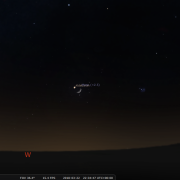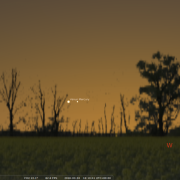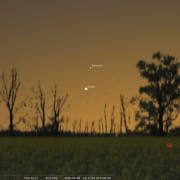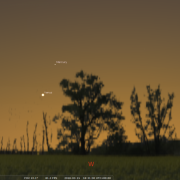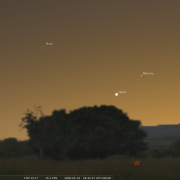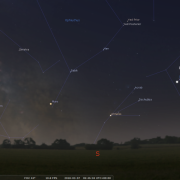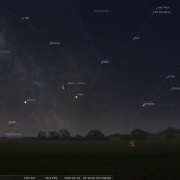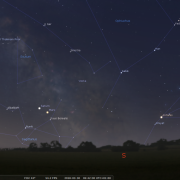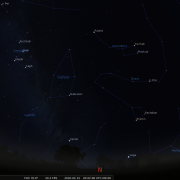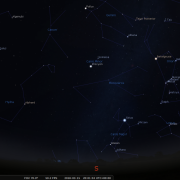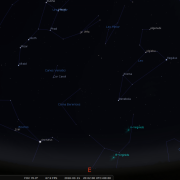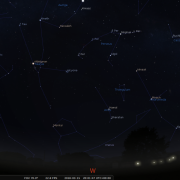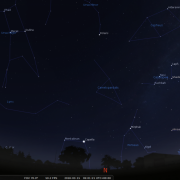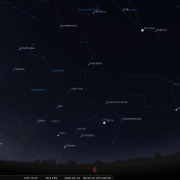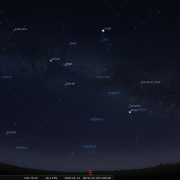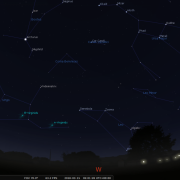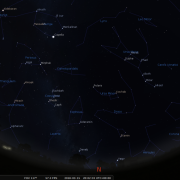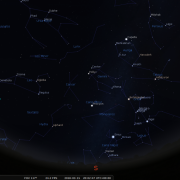Notes for Diary: Monthly Meeting: Tuesday 6th March; and consider as you stare into the snow scene through your window: British Summer Time starts on Sunday 25th March 2018.
Welcome to the WDAS monthly newsletter for March 2018: a digest of the month's latest contributions to our website. Below you'll find Society News, Sky Notes and another treat from the bakery, as well as coming events.
Society News
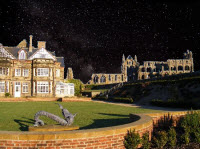 This was a last minute event – organised by the youth hostel. Conditions on the evening were actually very good with clear skies and little wind. Initially we thought hardly anyone was going to turn up, but by 18:30h a sizeable gathering had mustered on the front quadrangle in front of the Abbey Visitor centre.
This was a last minute event – organised by the youth hostel. Conditions on the evening were actually very good with clear skies and little wind. Initially we thought hardly anyone was going to turn up, but by 18:30h a sizeable gathering had mustered on the front quadrangle in front of the Abbey Visitor centre.
Mark performed the scale solar system, before observations were carried out, together with a laser tour of the sky. Thanks to Keith for his assistance on the night.
The second event the following evening down at Boggle Hole was cancelled due to the weather.
Together with other events at Dalby Forrest and Sutton bank, this was part of the NY National park’s dark sky awareness programme. February is always a tricky month weather wise, it could be anything, so it came as a relief that Saturday 17th proved to be a pretty quiet, clear day, a little chilly, but you expect that.
Having marshalled the troops at Mark’s, (Andi, John, Keith, Lee, Mark and Victor) the expedition set off for the centre in good time. The event was fully subscribed – 80 booked in - so a good audience was guaranteed. On arrival we were met by Karen and the team from the centre and our good friend John Randles had also made it down from Westerdale, so we had a decent selection of scopes deployed on the field in front of the centre, including the LX 200 making an all-too-rare winter outing.
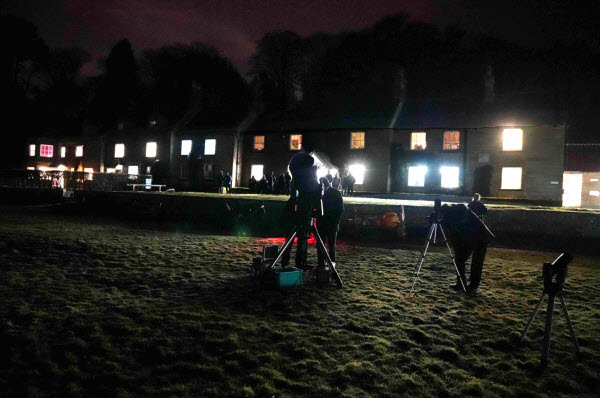
Dark Skies Event: 28th February 2018 at the Danby Moors Visitors Centre. Picture by Keith
Proceedings kicked off with the scale solar system demo, augmented by the inflatable planets, which had been pre inflated back in Whitby. The lighted globes were used in conjunction with these. The demo played particularly well, with plenty of coerced public involvement. It was then time to go to the scopes, whilst mark gave an extended laser point display. Sky conditions, although not universally pristine, were nevertheless still very good and views of various winter deep sky objects proved a hit.
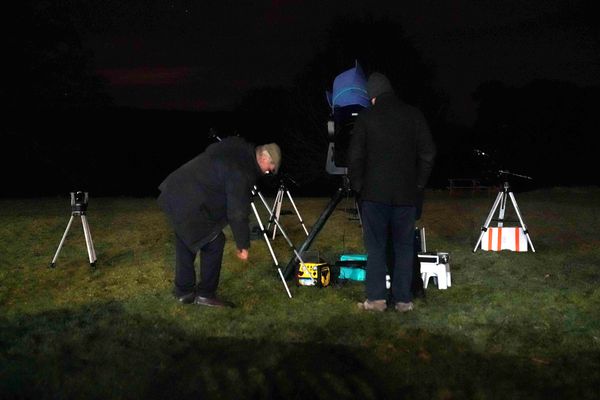
Dark Skies Event: 28th February 2018 at the Danby Moors Visitors Centre. Picture by Keith
Eventually Mark had to retire indoors to give the presentation he was supposed to have given earlier. Of course Windows in its infinite wisdom decided to update, just then, great!!! so Plan B came into hasty operation – using the Stellarium programme on the Centre’s IT suite. This proved to be just as satisfactory.
Proceedings finally drew to a close, our efforts much appreciated by all, indeed feedback was extremely positive – Karen thrilled the response. My thanks to the ‘band’ your dedication has been duly noted.
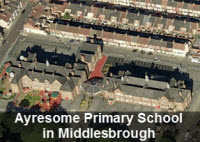 After been contacted by Elizabeth Labelle, Assistant Head Teacher (Phase3) of Ayresome Primary School & Lego Innovation Studio, we shall be hosting an event for visiting pupils up at the Whitby Youth Hostel on April 3rd /4th You may recall we did a similar event last year. The start time is around 20:15h.
After been contacted by Elizabeth Labelle, Assistant Head Teacher (Phase3) of Ayresome Primary School & Lego Innovation Studio, we shall be hosting an event for visiting pupils up at the Whitby Youth Hostel on April 3rd /4th You may recall we did a similar event last year. The start time is around 20:15h.
Sky Notes
In this month's Sky Notes:
Planetary Skylights
Following February, which saw no full Moon, March -like January - has two full Moons, the 2nd and 31st , the latter being yet another ‘rare’ blue moon.
 The Moon is also involved in two occultation’s of bright stars, Regulus in Leo on the morning of the 1st and Aldebaran in Taurus during the late evening of the 22nd. During an occultation the moon will pass in front of the star involved. On the 1st the Moon will occult Regulus from around 05:50h very low in the west. The Aldebaran occultation will commence around 23:00h and again will be low in the west sky.
The Moon is also involved in two occultation’s of bright stars, Regulus in Leo on the morning of the 1st and Aldebaran in Taurus during the late evening of the 22nd. During an occultation the moon will pass in front of the star involved. On the 1st the Moon will occult Regulus from around 05:50h very low in the west. The Aldebaran occultation will commence around 23:00h and again will be low in the west sky.


In the evening sky Venus and Mercury put on a splendid show for the first half of the month. You will locate them low in the west 40 minutes after sunset (around 18:00-18:15h). View on the 3rd when both lie side by side just over a degree apart. Venus will be far the brighter, but Mercury will be pretty conspicuous also (mag-1.2).
Over the course of the next two weeks, Mercury arcs up into the sky to around 10 degrees, reaching greatest elongation on the 15th before dropping back to the horizon by the end of the month. Venus climbs slowly into the sky during March. The Moon lies nearby on the 18th.


 In the dawn sky Jupiter, Mars and Saturn are all to be found. Jupiter is by far the most conspicuous residing to the south in the twilight sky. Mars lies well to the east Jupiter and over the course of March closes on Saturn located down in the southeast. The Moon lies close by on the 11th and 12th.
In the dawn sky Jupiter, Mars and Saturn are all to be found. Jupiter is by far the most conspicuous residing to the south in the twilight sky. Mars lies well to the east Jupiter and over the course of March closes on Saturn located down in the southeast. The Moon lies close by on the 11th and 12th.
Meteors

No major showers this month. However, at the very end of March you may spot a few Viginids, which are slow moving and have long paths. As usual early morning hours are best to spot any meteors.
March 2018 Sky Charts
|
Looking North
Mid-March - 20:00h |
Looking South |
|
Looking East
Mid-March - 20:00h |
Looking West
Mid-March - 20:00h |
| Looking North (morning) Mid-March - 05:00h |
Looking South (morning) Mid-March - 06:00h |
| Looking East (morning) Mid-March - 06:00h |
Looking West (morning) Mid-March - 05:00h |
| Northern Aspect Mid-March - 20:00h |
Southern Aspect Mid-March - 20:00h |
Additional Image Credits:
- Planets and Comets where not otherwise mentioned: NASA
- Sky Charts: Stellarium Software
The date of the Vernal Equinox and officially the start spring in the northern hemisphere falls on March 20th this year. This is when the Sun's path - the ecliptic, first crosses the celestial equator on its apparent journey northwards into the sky. The orientation of the Earth at the spring or autumnal equinox is such that neither of the poles are inclined towards the Sun and all locations experience equal hours of daylight and darkness - hence the term equinox.
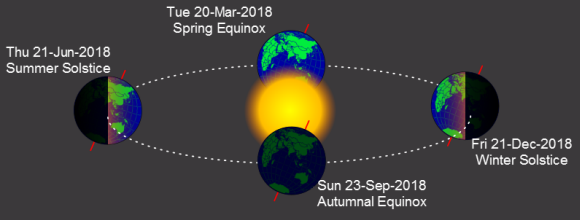
The Vernal Equinox is also known as the 'First point of Aries', as the Sun used to stand before the constellation of the Ram when it first crossed the celestial equator. Although still called the 'first point of Aries', today its location now resides in Pisces, a consequence of the effect known as precession - the Earth's slow wobble. Over thousands of years our ancestors noted that certain star patterns rose just before the Sun at specific times and were considered significant for this very reason. Subsequently they were able to build a picture of the apparent path of the Sun against these constellations.
The narrow path upon which occasionally the Sun and Moon would meet giving rise to an eclipse, became known as the Ecliptic. The broader belt along which the 'wandering stars' or planets travelled was known as the Zodiac, so called because all 12 constellations located on it were associated with living creatures.
Zodiac literally means 'Band of Animals'. Libra used to be considered being part of Scorpius, the claws to be precise. Ophiuchus, the serpent bearer immediately following Scorpius was instead regarded as a zodiac group. Ever since the stars of Libra were elevated in status, Ophiuchus, being surplus to requirements, was ditched, much to the relief of astrologers. If you find it difficult to remember the order of the zodiac constellations, then the following rhyme may be of use.
The Ram, the Bull, the Heavenly twins
and next the Crab the Lion shines,
the Virgin, and the Scales.
Scorpion, Archer and Sea goat,
the man who pours the water out
and Fish with glittering tails.

